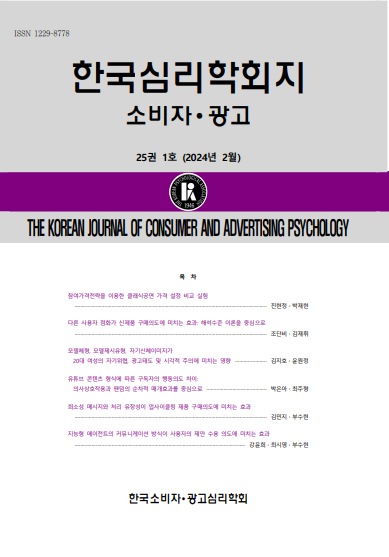open access
메뉴.png)
open access
메뉴 ISSN : 1229-8778
ISSN : 1229-8778
본 연구는 ‘한국심리학회지: 소비자․광고’에 게재되었던 논문들을 대상으로 연구분야, 연구자, 연구의 이론적 배경, 연구목적, 연구방법 측면에서 그 내용을 살펴보고, 이를 토대로 미래 소비자 연구 방향을 제안하고자 하였다. 2000년 창간호부터 2017년 18권 4호까지 18년 동안 발행된 59권의 ‘한국심리학회지: 소비자․광고’에 게재된 논문 총 448편을 대상으로 내용분석을 하였다. 분석결과는 학회지에 게재된 연구들의 전체 특성과, 동시에 18년간의 연구 동향이 어떻게달라졌는지에 대한 변화 추세를 모두 포함하고 있다. 주요 분석결과는 다음과 같다. 첫째, ‘한국심리학회지: 소비자․광고’에는 심리학과 소속 연구자들에 의한 논문이 전반적으로 높은 비중을 보이나, 최근 들어 경영학과 등 다른 전공 분야의 연구가 증가하고 있다. 이러한 현상은 소통과 융합이 중시되는 현시대적 특성을 잘 반영하고 있다. 둘째, 독립변인과 종속변인 간의 단선적 관계만을 규명하는 것을 넘어 조절변인과 매개변인의 역할을 보는 연구가 증가하고 있어소비자 및 광고심리학 연구의 진화를 짐작해볼 수 있다. 셋째로, 앞서 말한 다양한 소속에서의 연구가 진행되고 있는 것과 상반되게 대부분의 연구가 폭넓은 심리학이론을 기초로 하여 진행되었다기보다는 특정영역 이론에 치중되어 있었다. 특히 성격심리학, 인지심리학, 사회심리학의 이론을 바탕으로 하는 연구가 대다수여서 연구주제의 편중성이 보이며 소비자 및 광고심리학의 외현 확대가 절실하게 필요한 시점이다. 넷째, 조사연구, 질적연구방법, 생리적 측정을 기반으로 한 연구들이 매우 적으며 대부분의 연구가 실험연구에 의존하고 있다. 방법론의 편중은 곧 특정주제의 축소를 초래하게 되어, 변화하는 소비 현황을 폭넓게 파악하기 힘들며 혹은 소비자의 심리를 심층적으로 이해하는 연구가 부족하게 된다. 또는 소비자의 생물학적, 신체적 특성이 소비자와 어떤 관련이 있는지에 대한 연구 역시 수행하기 어려울 것이다. 다섯째, 소비시점 또는 매체활용에서 시대반영이 미흡하다는 것을 확인할 수 있었다. 특히 대부분의 연구가 구매전에 이뤄지는 현상을 보고 있으며 매체종류로 인쇄광고를 많이 활용하고 있다는 것은 이를 뒷받침한다. 끝으로 내용 분석 결과를 바탕으로 18년간 ‘한국심리학회지: 소비자․광고’ 연구가 어떻게 발전해왔는지를 분석한 후, 그중 바람직한 측면과 아쉬운 측면을 논하고 그것을 바탕으로 향후 연구 방향에 대한 제시를 논의 부분에서 다루었다.
The current paper aims to review the articles published in The Korean Journal of Consumer and Advertising Psychology, covering areas in the field of research, researcher, theoretical background of research, its objectives and methodology, and recommends future directions for consumer research. The analysis includes a total of 448 articles across 59 volumes of the journal’s 18-year history, from the publication of its first issue in 2000 to the 18th in 2017. The findings show the overall characteristics of research in academia, as well as how the research trend has evolved over the last 18 years. The key findings are as follows: First, in The Korean Journal of Consumer and Advertising Psychology, although the number of articles written by the researchers from the department of psychology has been higher in proportion, the number of research conducted by scholars from others fields, such as business is increasing in trend. This phenomenon precisely reflects how communication and integration are taken more importantly in a modern day society. Second, not only exploring the linear relationship of independent and dependent variables but also an increasing number of research examining moderating and mediating variables implies the potential progress in the relevant field of research. Third, contrary to what is mentioned earlier about interdisciplinary approach in conducting research, the theoretical background of most research is limited to narrow spectrum of topics in psychology. This indicates the large body of research is skewed in terms of theories used and thus, the necessity to widen scope of topics of studies in consumer and advertising psychology. Fourth, the majority of research today depends heavily on experimental studies, and there remains to be very few studies based on surveys, qualitative research, and biological measurements. This leads to a challenge in understanding the evolving state of consumption and a lack of research that explain the relationships between consumers’ biological or physical traits and their consumption behaviors. Fifth, the point of consumption studied and the types of media used reveal an inadequate reflection of time. This can be supported by the fact that most of the research observes scenes prior to consumption and that print advertising is the most commonly used medium. Finally, we discuss how the research in The Korean Journal of Consumer and Advertising Psychology has progressed over the past 18 years - its commendable components as well as areas of improvement -and provide recommendations for future research.
동아일보 (2017.06.10.). 맛집의 심리학. http://news.donga.com/3/all/20170327/83535447/1
아시아투데이 (2018.03.04..). 가성비․가심비이어 이제는 ‘가잼비’가 소비트렌드 http://www.asiatoday.co.kr/view.php?key=20180304010000743
양윤, 김완석, 남승규, 유승엽 (2009). 창간 10주년을 맞는 ‘한국심리학회지: 소비자․광고’. 한국심리학회지: 소비자․광고, 10(4), 601-610.
통계청 (2014). 한국재화 및 서비스분류. https://kssc.kostat.go.kr:8443/ksscNew_web/kssc/common/ClassificationContent.do?gubun=1&strC ategoryNameCode=047&categoryMenu=007&a ddGubun=no
한국마케팅연구원 편집부 (2012). 광고, 감성을말하다: 마음을 울리는 광고. 마케팅, 46 (6), 74-81.
Kalat, J. W. (2017). 심리학개론 (김문수, 강영신, 고재홍, 박소현, 박형생, 정윤경). 서울:사회평론아카데미. (원서출판 2013).
Schacter, D. L., Gilbert, D. T., Wegner, D. M., & Nock, M. K. (2016). 심리학개론 (민경환, 김명선, 김영진 옮김). 서울: 시그마프레스. (원서출판 2014).
Park, N., Kim, Y. C., Shon, H. Y., & Shim, H. (2013). Factors influencing smartphone use and dependency in South Korea. Computers in Human Behavior, 29(4), 1763-1770.
Wang, X., Bendle, N. T., Mai, F., & Cotte, J. (2015). The journal of consumer research at 40: A historical analysis. Journal of Consumer Research, 42(1), 5-18.
